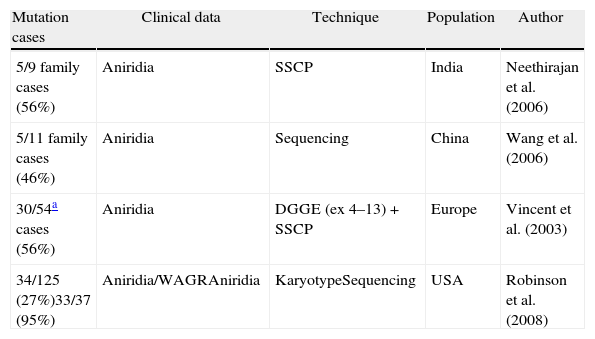Aniridia is a panocular disorder which occurs in 1/50,000 to 1/100,000 live births and can appear either in isolated form or in the context of a syndrome. Isolated aniridia is inherited as an autosomal dominant condition and is caused by mutations of the PAX6 gene. A variety of techniques and methodologies within molecular genetics and cytogenetics are used to study these mutations.
ObjectiveTo identify the different aspects of this disease and to provide a guide for proper genetic diagnosis leading to improved clinical management of the disease.
DevelopmentAniridia is an autosomal dominant disease that primarily affects the iris, though it can impact most of the ocular structures. The disease is mainly caused by mutations in the PAX6 gene located on chromosome 11p13 which encodes a transcription factor that is involved in the development of the eye. Genetic analysis of aniridia is complex and requires the use of both molecular genetics and cytogenetics techniques. These procedures are indicated in all cases of aniridia. It is important to bear certain clinical and technical aspects in mind prior to starting analysis or providing genetic counseling for patients and their families.
ConclusionsThe use of molecular genetic techniques in the genetic diagnosis of aniridia enables patients and their families to receive better clinical management.
La aniridia es una enfermedad panocular con una incidencia de entre 1/50.000 a 1/100.000 nacidos vivos, que puede presentarse de forma aislada o en el contexto de un síndrome. Presenta una herencia autosómica dominante y en la mayoría de los casos está causada por mutaciones en el gen PAX6, para cuyo estudio de mutaciones se emplea una gran variedad de técnicas y metodologías de genética molecular y citogenéticas.
ObjetivoRecoger los distintos aspectos de esta enfermedad y ofrecer una guía para el adecuado diagnóstico genético que ayude a un mejor manejo clínico de la misma.
DesarrolloLa aniridia es una enfermedad autosómica dominante que afecta fundamentalmente al iris, pero también puede afectar a la mayoría de las estructuras oculares. Está causada principalmente por mutaciones en el gen PAX6, ubicado en la región cromosómica 11p13, que codifica para una proteína reguladora de la transcripción imprescindible en el desarrollo del ojo. El análisis genético de la aniridia es complejo y requiere tanto de técnicas de genética molecular (secuenciación, CGH-array o MLPA) como citogenéticas (cariotipo y FISH). Este estudio está indicado en todos los casos de aniridia y es importante tener en cuenta ciertas consideraciones tanto clínicas como técnicas antes de abordar su análisis y el asesoramiento genético de los pacientes y familias afectados por esta enfermedad.
ConclusionesLa aplicación de técnicas de genética molecular al diagnóstico genético de la aniridia permite un mejor manejo clínico tanto de los afectados como de sus familiares.








